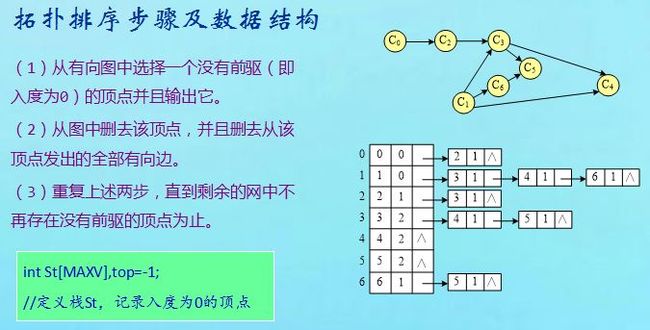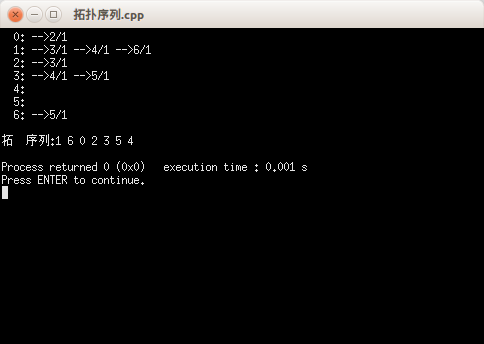图——拓扑序列
/*
*Copyright (c) 2015 , 烟台大学计算机学院
*All right resvered .
*文件名称: 拓扑序列.cpp
*作 者: 郑兆涵
*图——拓扑序列
*/
问题:写出图中的拓扑序列
测试用图为:
拓扑排序的步骤及数据结构:
编程代码:
//头文件:graph.h,包含定义图数据结构的代码、宏定义、要实现算法的函数的声明
#ifndef GRAPH_H_INCLUDED
#define GRAPH_H_INCLUDED
#define MAXV 100 //最大顶点个数
#define INF 32767 //INF表示∞
typedef int InfoType;
//以下定义邻接矩阵类型
typedef struct
{
int no; //顶点编号
InfoType info; //顶点其他信息,在此存放带权图权值
} VertexType; //顶点类型
typedef struct //图的定义
{
int edges[MAXV][MAXV]; //邻接矩阵
int n,e; //顶点数,弧数
VertexType vexs[MAXV]; //存放顶点信息
} MGraph; //图的邻接矩阵类型
//以下定义邻接表类型
typedef struct ANode //弧的结点结构类型
{
int adjvex; //该弧的终点位置
struct ANode *nextarc; //指向下一条弧的指针
InfoType info; //该弧的相关信息,这里用于存放权值
} ArcNode;
typedef int Vertex;
typedef struct Vnode //邻接表头结点的类型
{
Vertex data; //顶点信息
int count; //存放顶点入度,只在拓扑排序中用
ArcNode *firstarc; //指向第一条弧
} VNode;
typedef VNode AdjList[MAXV]; //AdjList是邻接表类型
typedef struct
{
AdjList adjlist; //邻接表
int n,e; //图中顶点数n和边数e
} ALGraph; //图的邻接表类型
//功能:由一个反映图中顶点邻接关系的二维数组,构造出用邻接矩阵存储的图
//参数:Arr - 数组名,由于形式参数为二维数组时必须给出每行的元素个数,在此将参数Arr声明为一维数组名(指向int的指针)
// n - 矩阵的阶数
// g - 要构造出来的邻接矩阵数据结构
void ArrayToMat(int *Arr, int n, MGraph &g); //用普通数组构造图的邻接矩阵
void ArrayToList(int *Arr, int n, ALGraph *&); //用普通数组构造图的邻接表
void MatToList(MGraph g,ALGraph *&G);//将邻接矩阵g转换成邻接表G
void ListToMat(ALGraph *G,MGraph &g);//将邻接表G转换成邻接矩阵g
void DispMat(MGraph g);//输出邻接矩阵g
void DispAdj(ALGraph *G);//输出邻接表G
#endif // GRAPH_H_INCLUDED
//源文件:graph.cpp,包含实现各种算法的函数的定义
#include <stdio.h>
#include <malloc.h>
#include "graph.h"
//功能:由一个反映图中顶点邻接关系的二维数组,构造出用邻接矩阵存储的图
//参数:Arr - 数组名,由于形式参数为二维数组时必须给出每行的元素个数,在此将参数Arr声明为一维数组名(指向int的指针)
// n - 矩阵的阶数
// g - 要构造出来的邻接矩阵数据结构
void ArrayToMat(int *Arr, int n, MGraph &g)
{
int i,j,count=0; //count用于统计边数,即矩阵中非0元素个数
g.n=n;
for (i=0; i<g.n; i++)
for (j=0; j<g.n; j++)
{
g.edges[i][j]=Arr[i*n+j]; //将Arr看作n×n的二维数组,Arr[i*n+j]即是Arr[i][j],计算存储位置的功夫在此应用
if(g.edges[i][j]!=0)
count++;
}
g.e=count;
}
void ArrayToList(int *Arr, int n, ALGraph *&G)
{
int i,j,count=0; //count用于统计边数,即矩阵中非0元素个数
ArcNode *p;
G=(ALGraph *)malloc(sizeof(ALGraph));
G->n=n;
for (i=0; i<n; i++) //给邻接表中所有头节点的指针域置初值
G->adjlist[i].firstarc=NULL;
for (i=0; i<n; i++) //检查邻接矩阵中每个元素
for (j=n-1; j>=0; j--)
if (Arr[i*n+j]!=0) //存在一条边,将Arr看作n×n的二维数组,Arr[i*n+j]即是Arr[i][j]
{
p=(ArcNode *)malloc(sizeof(ArcNode)); //创建一个节点*p
p->adjvex=j;
p->info=Arr[i*n+j];
p->nextarc=G->adjlist[i].firstarc; //采用头插法插入*p
G->adjlist[i].firstarc=p;
}
G->e=count;
}
void MatToList(MGraph g, ALGraph *&G)
//将邻接矩阵g转换成邻接表G
{
int i,j;
ArcNode *p;
G=(ALGraph *)malloc(sizeof(ALGraph));
for (i=0; i<g.n; i++) //给邻接表中所有头节点的指针域置初值
G->adjlist[i].firstarc=NULL;
for (i=0; i<g.n; i++) //检查邻接矩阵中每个元素
for (j=g.n-1; j>=0; j--)
if (g.edges[i][j]!=0) //存在一条边
{
p=(ArcNode *)malloc(sizeof(ArcNode)); //创建一个节点*p
p->adjvex=j;
p->info=g.edges[i][j];
p->nextarc=G->adjlist[i].firstarc; //采用头插法插入*p
G->adjlist[i].firstarc=p;
}
G->n=g.n;
G->e=g.e;
}
void ListToMat(ALGraph *G,MGraph &g)
//将邻接表G转换成邻接矩阵g
{
int i,j;
ArcNode *p;
g.n=G->n; //根据一楼同学“举报”改的。g.n未赋值,下面的初始化不起作用
g.e=G->e;
for (i=0; i<g.n; i++) //先初始化邻接矩阵
for (j=0; j<g.n; j++)
g.edges[i][j]=0;
for (i=0; i<G->n; i++) //根据邻接表,为邻接矩阵赋值
{
p=G->adjlist[i].firstarc;
while (p!=NULL)
{
g.edges[i][p->adjvex]=p->info;
p=p->nextarc;
}
}
}
void DispMat(MGraph g)
//输出邻接矩阵g
{
int i,j;
for (i=0; i<g.n; i++)
{
for (j=0; j<g.n; j++)
if (g.edges[i][j]==INF)
printf("%3s","∞");
else
printf("%3d",g.edges[i][j]);
printf("\n");
}
}
void DispAdj(ALGraph *G)
//输出邻接表G
{
int i;
ArcNode *p;
for (i=0; i<G->n; i++)
{
p=G->adjlist[i].firstarc;
printf("%3d: ",i);
while (p!=NULL)
{
printf("-->%d/%d ",p->adjvex,p->info);
p=p->nextarc;
}
printf("\n");
}
}
//编写main函数,进行相关测试
#include <stdio.h>
#include <malloc.h>
#include "graph.h"
void TopSort(ALGraph *G)
{
int i,j;
int St[MAXV],top=-1; //栈St的指针为top
ArcNode *p;
for (i=0; i<G->n; i++) //入度置初值0
G->adjlist[i].count=0;
for (i=0; i<G->n; i++) //求所有顶点的入度
{
p=G->adjlist[i].firstarc;
while (p!=NULL)
{
G->adjlist[p->adjvex].count++;
p=p->nextarc;
}
}
for (i=0; i<G->n; i++)
if (G->adjlist[i].count==0) //入度为0的顶点进栈
{
top++;
St[top]=i;
}
while (top>-1) //栈不为空时循环
{
i=St[top];
top--; //出栈
printf("%d ",i); //输出顶点
p=G->adjlist[i].firstarc; //找第一个相邻顶点
while (p!=NULL)
{
j=p->adjvex;
G->adjlist[j].count--;
if (G->adjlist[j].count==0)//入度为0的相邻顶点进栈
{
top++;
St[top]=j;
}
p=p->nextarc; //找下一个相邻顶点
}
}
}
int main()
{
ALGraph *G;
int A[7][7]=
{
{0,0,1,0,0,0,0},
{0,0,0,1,1,0,1},
{0,0,0,1,0,0,0},
{0,0,0,0,1,1,0},
{0,0,0,0,0,0,0},
{0,0,0,0,0,0,0},
{0,0,0,0,0,1,0}
};
ArrayToList(A[0], 7, G);
DispAdj(G);
printf("\n");
printf("拓扑序列:");
TopSort(G);
printf("\n");
return 0;
}
输出结果:


